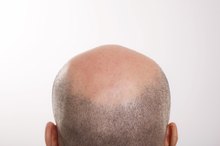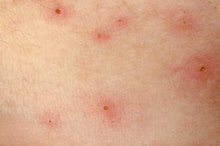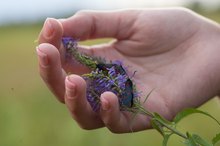11 Warning Signs Your Skin Is Sending You
You know that rash that won’t go away? Or the breakouts erupting in strange spots? Rashes, growths and skin conditions can often be a clue that something much more severe is going on inside the body, says J. Matthew Knight, M.D., a dermatologist with Knight Dermatology Institute. But not every bump or freckle means something is up. “Many skin conditions can mimic others, and appearance alone is rarely indicative of the exact problem at hand,” says Joel Schlessinger, M.D., a Nebraska-based dermatologist and RealSelf contributor. In most cases, you’ll experience a handful of symptoms that indicate it’s time to visit a doctor. Read on to learn what your skin might be trying to tell you.
1. Acne Along the Chin and Jaw
Anything from diet to genetics can play a role in where and how frequently you break out, says Dr. Joel Schlessinger. But sometimes intense breakouts could be a sign of a more serious health issue. “For women, acne located in the lower face area, such as the chin and jawline, is often an indicator of hormonal imbalance,” Dr. Schlessinger says. It could end up being the result of a number of different conditions, including polycystic ovarian syndrome (PCOS), which is a treatable condition that can affect a woman’s ability to conceive. Other signs of PCOS include skin tags, dark patches of skin, irregular periods and hair growth in strange areas, such as on the face, arms and thumbs.
Read more: 10 Foods That Are Bad for Your Skin
2. Abnormally Pale Skin
Scalp Conditions That Cause Hair Loss
Learn More
Nope, it’s not just a sign that you’re in desperate need of a tropical vacation. Pale skin, especially the lips, could signal that you are anemic, meaning your red blood cell count is low. But, of course, you could just be sporting a paler hue because you’re avoiding the sun (which does have some positive health implications). So if you’re concerned about blood iron levels, be on the lookout for other symptoms of anemia, including feeling excessively tired, dizzy or plowed down by headaches.
Listen now: Why America’s Obsession with ‘Happiness’ Is Totally Stressing Us Out
3. Painful Bumps
Acne-like bumps that hurt and pop up in weird areas, such as your stomach, armpits or groin, could be a sign of the chronic skin disease hidradenitis suppurativa (also called acne inversa). They’re relatively easy to spot because the boils normally erupt symmetrically on opposite sides of the body. In other words, they occur in the exact same place on your left side and right side. The other tip-off HS could be the culprit? You’re battling other health issues, such as diabetes, metabolic syndrome or heart disease.
4. Yellow-Tinted Skin
Keratin Levels
Learn More
Noticing a yellow tint to your skin and eyes could be a sign that your liver isn’t functioning properly and you have a condition known as jaundice. Other things to look out for: Your urine may be a bit darker than usual, and your stool might be light in color, a sign that your bile duct is blocked. The skin symptoms alone should be enough for your doctor to determine if jaundice is the problem, says Dr. J. Matthew Knight. Your doctor will likely be able to identify it the second you walk through the door and can then determine whether you have hepatitis or another liver condition.
Read more: Visit the LIVESTRONG.COM Hepatitis C Condition Center
5. Very Dry Skin
Many factors contribute to dry skin, including something as simple as taking showers that are too hot, Dr. J. Matthew Knight says. But chronic, severely dry skin that’s super itchy could signal an underactive thyroid, says Dr. Joel Schlessinger. The condition, also known as hypothyroidism, occurs in about five of every 100 American adults, with women being more likely to develop it than men. Be on the lookout for other symptoms, such as hair loss, weight gain and muscle pain.
6. Intense, Unusual Itchiness
Bug bites. Dry skin. Allergies. “There are a lot of reasons to itch, trust me,” Dr. J. Matthew Knight says. But really intense itching could be a sign your kidneys are in trouble. “People who have renal insufficiencies — and they don’t know it and they’re itching like crazy — sometimes they’re in the early stages of renal failure,” Knight says. The itchiness is technically called pruritus and has been found among 20 to 50 percent of patients with late stages of renal disease, according to a 2013 study from California researchers.
Read more: 9 Ways to Keep Your Skin Looking Great
7. Tan, Thick, Velvety Skin
Is your skin taking on an odd color and texture? You might be diabetic or prediabetic. A skin disorder called acanthosis nigricans (AN) results in dark, velvety patches of skin, primarily in body folds and creases like the armpits, groin or neck and possibly the knees and elbows. It can be the result of being overweight and a sign that a diabetes diagnosis is around the corner, according to the American Diabetes Association. The good news is that getting this checked out early means there’s likely time to change up your sugar intake and dodge the disease before it occurs, says Dr. Joel Schlessinger.
8. Flare-Up of Hives or Psoriasis
If you’ve ever noticed a rash that’s perfectly timed with a big work project, you’re well aware of the physical ways stress can manifest itself. That’s an example of the mind-body connection in action. “Most skin conditions, in my experience, can be exacerbated by personal stress,” Dr. J. Matthew Knight says. “It’s common for someone who’s exposed to things like psoriasis or hair loss or hives to say they’re going through a really hard time, whether it’s divorce, work or they’re not sleeping because the kids are up all night.” Most of the time, stress will make existing skin problems worse rather than causing the problems out of nowhere, though, says Dr. Knight.
Read more: 10 Weird Side Effects of Stress
9. Itchy Blisters
Celiac disease, an autoimmune disease marked by the body’s inability to deal with gluten, has a number of symptoms, most of which are related to digestive problems. But about 10 percent of celiac patients — especially those in the 30- to 40-year-old range — will also experience itchy blisters on the knees, elbows, back, scalp or butt. Sometimes these blisters will be their only symptom.
10. Rash Across the Face
Lupus, an autoimmune disease that causes the immune system to attack healthy cells, got its name from the Latin word for wolf. “The reason it got that term is because the patients get this rash across their face that looks like a wolf bite,” says Dr. J. Matthew Knight. The rash — sometimes called a “butterfly rash” because it’s usually spread across the face in the shape of a butterfly — will usually be accompanied by other skin and nail symptoms, such as pale or purple fingers and toes and swelling around the eyes or in the legs.
11. Nail Changes
Yellow skin aside, spotting on your nails could also be a bigger issue — namely that you’re dealing with a bronchial infection or the beginning of psoriasis (even without any other skin changes), says Dr. Joel Schlessinger. Nail changes go hand in hand with other health conditions too. “Clubbing, where the nail curves over the edge and the pad of the finger enlarges or swells, can be a sign of heart or lung disease,” Schlessinger adds. “And lines with a slight indentation can indicate a shock to the system, such as poor nutrition or a form of nail shock from chemotherapy treatments.”
What Do YOU Think?
Have you ever experienced these skin conditions yourself? Did it indicate an underlying issue? Or are you experiencing these now and think it’s time to see a doctor? Let us know in the comments below!
Read more: 10 Ways Your Face Reveals Health Problems
Related Articles
- vadimguzhva/iStock/Getty Images









